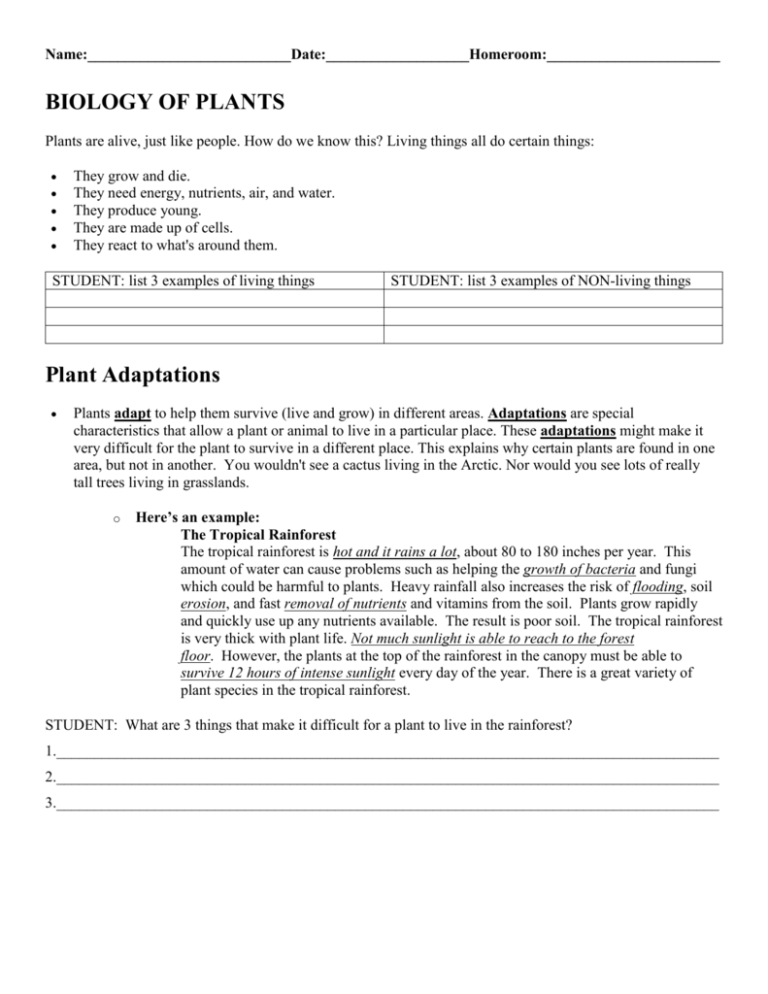Plant Adaptations Worksheet
advertisement

Name:___________________________Date:___________________Homeroom:_______________________ BIOLOGY OF PLANTS Plants are alive, just like people. How do we know this? Living things all do certain things: They grow and die. They need energy, nutrients, air, and water. They produce young. They are made up of cells. They react to what's around them. STUDENT: list 3 examples of living things STUDENT: list 3 examples of NON-living things Plant Adaptations Plants adapt to help them survive (live and grow) in different areas. Adaptations are special characteristics that allow a plant or animal to live in a particular place. These adaptations might make it very difficult for the plant to survive in a different place. This explains why certain plants are found in one area, but not in another. You wouldn't see a cactus living in the Arctic. Nor would you see lots of really tall trees living in grasslands. o Here’s an example: The Tropical Rainforest The tropical rainforest is hot and it rains a lot, about 80 to 180 inches per year. This amount of water can cause problems such as helping the growth of bacteria and fungi which could be harmful to plants. Heavy rainfall also increases the risk of flooding, soil erosion, and fast removal of nutrients and vitamins from the soil. Plants grow rapidly and quickly use up any nutrients available. The result is poor soil. The tropical rainforest is very thick with plant life. Not much sunlight is able to reach to the forest floor. However, the plants at the top of the rainforest in the canopy must be able to survive 12 hours of intense sunlight every day of the year. There is a great variety of plant species in the tropical rainforest. STUDENT: What are 3 things that make it difficult for a plant to live in the rainforest? 1.________________________________________________________________________________________ 2.________________________________________________________________________________________ 3.________________________________________________________________________________________ Tropical Rainforest Plant Adaptations drip tips and waxy surfaces allow water to run off, to discourage growth of bacteria and fungi some plants grow on other plants to reach the sunlight plants have shallow roots to help capture nutrients from the top level of soil. STUDENT: Choose ONE rainforest plant adaptation, CIRCLE it then use your imagination to illustrate what that adaptation would look like—no “stick” drawings and color encouraged. LABEL and EXPLAIN Explanation: Use your notes to label the parts of this flower. Be sure to include: stamen, pistil, ovary, and anther. You will have one box left over. How Do Plants Get Pollinated? People can transfer pollen from one flower to another, but most plants are pollinated without any help from people. Usually plants rely on animals or the wind to pollinate them. When animals such as bees, butterflies, moths, flies, and hummingbirds pollinate plants, it's accidental. They are not trying to pollinate the plant. Usually they are at the plant to get food. The animals accidentally rub against the stamens and get pollen stuck all over themselves. When they move to another flower to feed, some of the pollen can rub off onto this new plant's stigma. Another way plants are pollinated is by the wind. The wind picks up pollen from one plant and blows it onto another. STUDENT: Name 5 living organisms that might pollinate a flower1. 2. 3. 4. 5. Seed Dispersal (makes plant populations bigger) To disperse is a verb that means to spread farther. After a plant has been pollinated, it will grow its own seeds inside of it. Plants have adapted some fast ways to spread their seeds to far off places so their entire species will expand. You might think people are responsible for spreading seeds but that is not true. People plant some seeds, but most plants don't rely on people. Plants rely on animals and wind and water to help scatter their seeds. Animal dispersal Animals disperse seeds in several ways. First, some plants get tangled in animal fur or feathers, and are carried to new places. Other plants produce their seeds inside fruits that get eaten by an animal. The fruit is digested by the animal, but the seeds pass through the digestive tract, and are dropped in other locations when the animal goes to the bathroom. Some animals bury seeds, like squirrels with acorns, to save for later, but may not return to get the seed. It can grow into a new plant. Summarize the TWO ways that animals disperse seeds 1.________________________________________________________________________________________ __________________________________________________________________________________________ 2.________________________________________________________________________________________ __________________________________________________________________________________________ Wind dispersal The kind of seeds which are often moved by the wind are smaller seeds that have wings or other hair-like or feather-like structures. Plants that produce windblown seeds, like the dandelion, often produce lots of seeds to ensure that some of the seeds are blown to areas where the seeds can grow. Directions: Use the description above, your imagination or prior knowledge to draw a wind dispersing seed or plant. Floating in water Many plants that live near water have seeds that can float, and are carried by water. Plants living along streams and rivers have seeds that float downstream, and are carried by the water to new places. The size of the seed does not matter for whether or not a seed can float. Some very large seeds, like coconuts, can float. Some small seeds also float. Directions: Apply your new knowledge--Why might islands have so many coconut trees on them? __________________________________________________________________________________________ __________________________________________________________________________________________ __________________________________________________________________________________________





